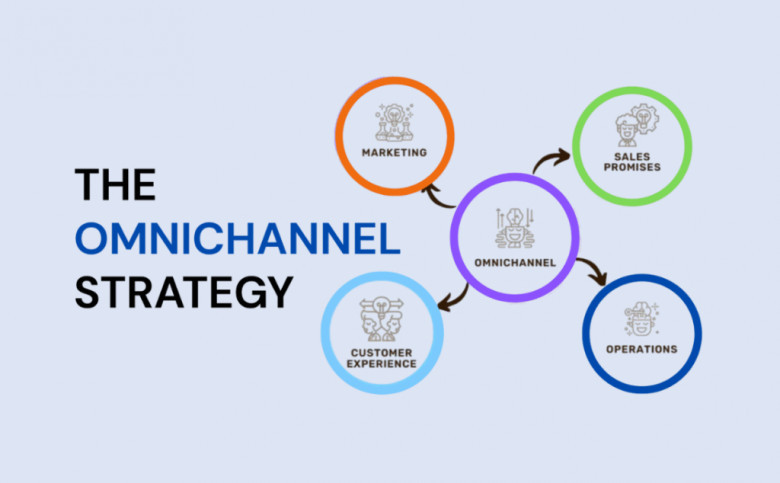views
Omnichannel Strategy in B2B: How to Engage and Convert Modern Buyers

“You’ve got to start with the customer experience and work back toward the technology — not the other way around.”
— Steve Jobs
In today’s always-connected world, buyers don’t just expect convenience — they demand it. B2B buyers, much like consumers, navigate multiple channels before making a purchasing decision. From website browsing and email campaigns to social media, webinars, and even offline touchpoints, their journey is non-linear and complex. That’s where the power of an omnichannel strategy comes into play.
Unlike multichannel marketing, which merely offers presence across platforms, omnichannel ensures a seamless, consistent experience throughout the buyer’s journey, regardless of where or how that journey begins. This strategy has evolved from being a buzzword to a business necessity.
In this blog post, we will explore:
· What is an omnichannel strategy?
· Why it matters in B2B lead generation
· Omnichannel vs. multichannel marketing
· Benefits of an omnichannel approach
· Key components of a successful omnichannel strategy
· Real-world B2B examples
· Tools to help you implement omnichannel marketing
· Challenges and how to overcome them
· Final takeaways
Let’s dive in.
For More Information: https://pangeaglobalservices.com/omnichannel-strategy-in-b2b-how-to-engage-and-convert-modern-buyers/
1# What Is an Omnichannel Strategy?
An omnichannel strategy refers to a unified marketing and sales approach where a company delivers a connected customer experience across all touchpoints — online and offline. This means that whether your prospect interacts with your brand via LinkedIn, email, your website, a webinar, or a phone call, the communication feels consistent and personalized.
Key Characteristics:
· Unified brand messaging
· Integrated data and technology stack
· Consistent user experience
· Real-time personalization
The goal is to remove friction from the customer journey, helping buyers make informed decisions faster and more confidently.
2# Why Omnichannel Matters in B2B Lead Generation
Modern B2B buyers conduct extensive research across various channels before making purchasing decisions. According to a McKinsey report, B2B buyers use six or more channels during their decision-making journey. An omnichannel approach ensures that no matter which route they take, you’re there to guide them.
B2B Buying Habits That Favor Omnichannel
· Multiple decision-makers: A typical B2B deal involves 6–10 stakeholders
· Extended sales cycles: Nurturing happens over weeks or months
· Demand for personalization: B2B buyers expect relevant and timely content
· Digital transformation: Remote and hybrid work has increased digital touchpoints
The complexity and scale of B2B transactions make it critical to offer a journey that is not only informative but also cohesive. Omnichannel strategies help companies build lasting relationships by maintaining relevance and trust across every interaction.
3# Omnichannel vs. Multichannel: What’s the Difference?
While both strategies involve using more than one communication channel, the fundamental difference lies in integration.
|
Feature |
Multichannel |
Omnichannel |
|
Channel Integration |
Minimal or none |
Fully integrated |
|
User Experience |
Fragmented |
Seamless and unified |
|
Data Sharing |
Siloed |
Shared across platforms |
|
Personalization Level |
Low |
High |
|
Business Objective |
Presence |
Engagement and conversion |
|
|
|
|
A multichannel approach often feels disjointed. The customer may get different messages from email, social media, and sales calls. In contrast, omnichannel marketing ensures that all touchpoints work together, sharing data and insights in real time.
Our Services:https://pangeaglobalservices.com/our_services/lead-management/
4# Benefits of an Omnichannel Strategy for B2B Companies
1. Improved Customer Experience
Omnichannel delivers a unified experience by connecting all platforms, allowing customers to transition smoothly from one channel to another.
2. Increased Lead Engagement
When leads encounter timely and relevant information consistently, they are more likely to interact, reply, and engage with your brand.
3. Higher Conversion Rates
Each touchpoint reinforces the next, reducing confusion and drop-offs. This increases the chances of a successful conversion.
4. Better Data-Driven Insights
Centralizing customer data enables better tracking of behavior, preferences, and performance metrics across the funnel.
5. Stronger Brand Recall
Consistent branding and messaging help reinforce your value proposition, making your brand more memorable.
6. Enhanced Personalization
The ability to track user interactions across platforms allows for hyper-personalized messaging that addresses individual pain points.
7. Reduced Customer Churn
A well-integrated experience fosters loyalty, leading to improved retention rates and increased lifetime value.
5# Key Components of a B2B Omnichannel Strategy
1. Audience Segmentation
Start by clearly defining your Ideal Customer Profile (ICP) and segmenting based on:
· Industry
· Job title
· Engagement behavior
· Stage in the buying journey
2. Channel Selection
Choose your channels wisely based on buyer preferences. Common B2B channels include:
· Email marketing
· LinkedIn and Twitter
· SEO and content marketing
· Paid advertising (Google Ads, LinkedIn Ads)
· Webinars and online demos
· Sales outreach (calls, SMS, WhatsApp)
3. Centralized Data Management
A single customer view is essential. Use tools that aggregate and sync data across platforms:
· HubSpot
· Salesforce
· Segment
· Zoho CRM
4. Personalized Messaging
Tailor content to match the buyer’s journey using behavioral triggers and demographic insights:
· Welcome sequences
· Content-based nurturing
· Retargeting ads
· Event invites based on industry role
5. Automation & AI Tools
Omnichannel marketing is made scalable through smart automation. Platforms like:
· Marketo
· ActiveCampaign
· Pardot
· Customer.io
These tools automate lead scoring, behavior tracking, triggered emails, and A/B testing.
6. Analytics & Optimization
Use data to improve decision-making and ROI. Essential KPIs include:
· Customer acquisition cost (CAC)
· Marketing qualified leads (MQLs)
· Channel-specific conversion rates
· Engagement scores
· Return on ad spend (ROAS)
Our services:https://pangeaglobalservices.com/our_services/account-based-marketing/
6# Real-World Example: Omnichannel in Action
Company: Salesforce










